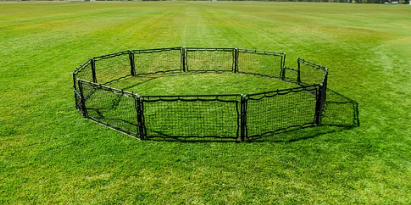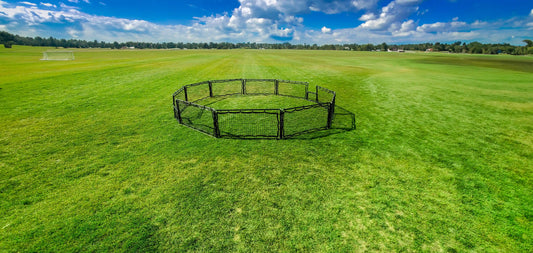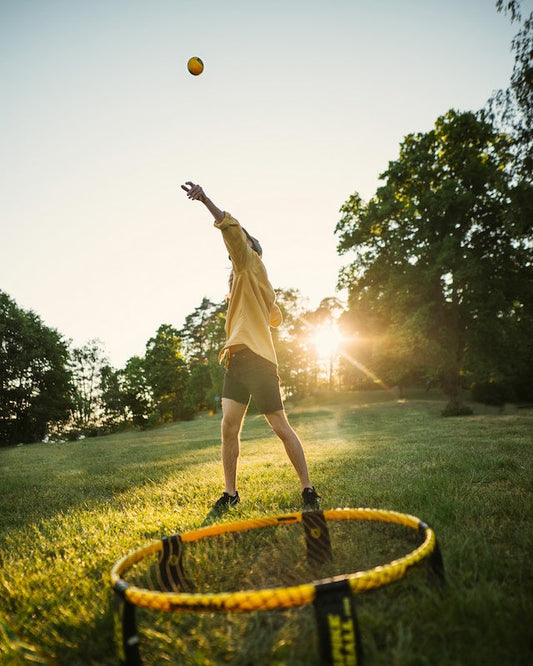Floor hockey is a fast-paced and dynamic sport that shares similarities with ice hockey but is played on a flat, indoor surface. It's a popular and accessible game that allows players to enjoy the excitement of hockey without the need for ice or roller skates. Floor hockey is often played in schools, recreational centers, and organized leagues. Here's an in-depth explanation of floor hockey:
Objective:
The primary goal of floor hockey is to score more goals than the opposing team. Teams achieve this by maneuvering a puck or ball into the opponent's goal using sticks.
Equipment:
Sticks: Players use floor hockey sticks, which have a flat blade at one end for handling the puck or ball.
Puck or Ball: Depending on the variation of floor hockey being played, a puck or a ball is used as the playing object.
Goals: Similar to ice hockey, there are goals at either end of the playing area. The objective is to shoot the puck or ball into the opposing team's goal to score.
Protective Gear: Depending on the level of play, players may wear protective gear such as helmets, shin guards, and gloves.
Team Composition:
Players: A standard floor hockey team typically consists of six players, including a goaltender. Teams can vary in size depending on the playing format.
Playing Area:
Court: The game is played on a flat, indoor surface. The size of the playing area can vary based on the level of play, but it generally resembles the dimensions of a basketball court.
Goals: Goals are positioned at each end of the court, and the objective is to shoot the puck or ball into the opponent's goal.
Rules and Gameplay:
Starting Play: The game begins with a face-off at center court, where the referee drops the puck or ball between two players from each team.
Scoring: Players aim to shoot the puck or ball into the opposing team's goal. A goal is scored when the entire puck or ball crosses the goal line.
Stick Handling: Players use their floor hockey sticks to handle the puck or ball. They can pass, shoot, and control the puck using the flat side of the blade.
Passing and Shooting: Teamwork is crucial, and players often engage in strategic passing to create scoring opportunities. Shooting skills are essential for players aiming to score goals.
Defense: Defenders work to prevent the opposing team from scoring by blocking shots, intercepting passes, and clearing the puck or ball from their defensive zone.
Goaltending: The goaltender plays a vital role in defending the team's goal. They use a larger goalie stick and often wear additional protective gear to stop shots on goal.
Penalties: Floor hockey has rules governing player conduct, and penalties may be enforced for infractions such as tripping, slashing, or unsportsmanlike behavior.
Game Duration: Floor hockey games are typically divided into periods, and the team with the most goals at the end of the designated time wins.
Floor hockey is a versatile sport with variations that include different playing surfaces, rules, and equipment. It's a fantastic way for players of all ages and skill levels to enjoy the excitement of hockey in an indoor setting. Whether played for recreation or as part of organized leagues, floor hockey offers a unique blend of skill, strategy, and teamwork that makes it a popular and enduring sport.
Here at Castle Sports when we aren't playing 9 Square or Gaga Ball we love to play floor hockey games. Below we will discuss some of our favorites!
Floorball

Floorball is a fast-paced indoor team sport that originated in Sweden in the 1970s. It has since gained popularity worldwide and is played at both recreational and competitive levels. Floorball is often described as a combination of ice hockey, field hockey, and soccer, played with a lightweight plastic ball and specialized sticks. Here's a detailed explanation of the game:
Objective:
The primary objective in floorball is to score goals by shooting the ball into the opponent's goal. Each team aims to outscore the other within a designated time frame.
Equipment:
Floorball Sticks: Specialized lightweight sticks are used by players. These sticks have a plastic blade at one end for controlling and shooting the ball.
Floorball Ball: The game is played with a lightweight, perforated plastic ball. The ball is designed to roll smoothly on the playing surface.
Goals: Similar to hockey, there are two goals at opposite ends of the playing area. The goals are slightly smaller than traditional hockey goals.
Protective Gear: Players typically wear jerseys, shorts, and non-marking indoor sports shoes. Goalkeepers may wear additional protective gear, including a helmet, gloves, and padded clothing.
Team Composition:
Players: A standard floorball team consists of six outfield players and one goalkeeper. Teams may have additional players for substitutions.
Playing Area:
Court: The game is played on a rectangular court with boards or barriers along the sidelines. The dimensions of the court may vary but are typically smaller than a standard ice hockey rink.
Rules and Gameplay:
Starting Play: The game begins with a face-off at center court, where the referee drops the ball between two players.
Passing and Shooting: Players use their sticks to pass, shoot, and control the ball. The objective is to maneuver the ball strategically to create goal-scoring opportunities.
Goalkeeping: The goalkeeper plays a crucial role in defending the team's goal. They use their hands, feet, and stick to prevent the opposing team from scoring.
No Offside Rule: Unlike some forms of hockey, floorball generally does not have an offside rule. Players can position themselves anywhere on the court.
Violations and Penalties: Common violations include high sticking, tripping, and obstruction. Players committing such infractions may face penalties, resulting in power plays for the opposing team.
Scoring: A goal is scored when the entire ball crosses the goal line between the goalposts. The team with the most goals at the end of the designated playing time wins.
Face-Offs: Face-offs occur at various points on the court after stoppages in play.
Running Clock: The game is typically played with a running clock, stopping only for timeouts, injuries, or other specific situations.
Floorball is known for its fast-paced nature, quick transitions, and emphasis on skillful ball control. It is played indoors, making it accessible throughout the year. Floorball has gained recognition as a sport that combines elements of strategy, teamwork, and individual skill, making it suitable for players of various ages and levels of experience.
Bandy

Bandy is a team sport that shares similarities with ice hockey and soccer but is played on a large ice surface or can be deviated to play as floor hockey. It originated in England in the 19th century and is particularly popular in Nordic countries, Russia, and other regions with cold climates. Bandy is played with a ball instead of a puck, and the objective is to score goals by hitting the ball into the opposing team's goal using sticks. Here's an explanation of the game:
Objective:
The primary goal in bandy is to score more goals than the opposing team. Teams achieve this by hitting a ball with a curved stick into the opponent's goal.
Equipment:
Bandy Stick: Players use a stick with a curved end to control and hit the ball. The stick is similar in shape to those used in field hockey but has a longer blade.
Bandy Ball: Bandy is played with a ball, not a puck. The ball is made of rubber or a similar material and is smaller than a soccer ball.
Goals: There are two goals at each end of the ice rink. The goals are larger than those used in ice hockey.
Team Composition:
Players: A standard bandy team consists of 11 players, including a goalkeeper. Teams may have substitutes that can be used during the game.
Playing Area:
Ice Rink: Bandy is played on a large ice rink, which is significantly larger than an ice hockey rink. The dimensions can vary, but the playing surface is typically closer in size to a soccer field.
Rules and Gameplay:
Starting Play: The game begins with a face-off at the center of the rink, where the referee drops the ball between two players.
Passing and Shooting: Players use their sticks to pass, control, and shoot the ball. The objective is to score goals by hitting the ball into the opponent's goal.
Goalkeeping: The goalkeeper plays a vital role in defending the team's goal. Goalkeepers use their body and stick to block shots and prevent goals.
No Offside Rule: Bandy generally does not have an offside rule. Players can position themselves anywhere on the ice.
Violations and Penalties: Common violations include high sticking, tripping, and holding. Players committing infractions may face penalties, resulting in power plays for the opposing team.
Icing: Similar to ice hockey, icing rules may apply in certain situations.
Halftime: Bandy games are typically divided into two halves with a halftime break.
Winning: The team with the most goals at the end of the game is declared the winner.
Bandy is known for its fast-paced nature, teamwork, and skillful play. The sport requires endurance, as players cover a significant distance on the ice. It is particularly popular in countries with a strong winter sports tradition, and international bandy competitions attract teams from various nations.
Ringette

Ringette is a team sport that originated in Canada in the early 1960s and was specifically designed as a fast-paced and non-contact alternative to ice hockey for girls and women. It has since evolved into a popular sport played by both genders. Ringette is played on an ice rink, and the players use a straight stick to control a rubber ring, aiming to score goals by shooting the ring into the opposing team's net. Here's a detailed explanation of the game:
Objective:
The primary goal in ringette is to score goals by getting a rubber ring into the opponent's goal. The team with the most goals at the end of the game wins.
Equipment:
Ringette Stick: Players use a straight stick, similar to a hockey stick, with a specially designed end to control and shoot the ring.
Ring: The playing object is a rubber ring with a small opening in the center. The ring is smaller than a puck used in ice hockey.
Goal: There are two goals at each end of the ice rink, similar to ice hockey goals.
Team Composition:
Players: A standard ringette team consists of six players on the ice at a time, including a goaltender. Teams may have additional players for substitutions.
Playing Area:
Ice Rink: Ringette is played on an ice rink, and the dimensions of the rink are similar to those used in ice hockey.
Rules and Gameplay:
Starting Play: The game begins with a face-off at center ice, where the referee drops the ring between two opposing players.
Passing and Shooting: Players use their sticks to pass, control, and shoot the ring. The objective is to score goals by shooting the ring into the opposing team's goal.
No Checking: Ringette is a non-contact sport, and checking is not allowed. Players use positioning, stick skills, and speed to navigate the ice.
Free Play Zone: Certain areas around the net, known as the "free play zone," have special rules. For example, players cannot carry the ring into the free play zone; instead, they must pass or shoot it in.
Goalkeeping: The goaltender plays a crucial role in defending the team's goal. Goalkeepers use their body and stick to block shots and prevent goals.
Shot Clock: In some variations, there is a shot clock to prevent stalling and encourage continuous play.
Violations and Penalties: Penalties may be called for various infractions, such as interference, slashing, or tripping. During a penalty, the penalized team plays short-handed.
Halftime: Ringette games are typically divided into two halves with a halftime break.
Winning: The team with the most goals at the end of the game is declared the winner.
Ringette is known for its fast-paced gameplay, teamwork, and skillful play. It has gained popularity in Canada, Scandinavia, and other regions with strong winter sports traditions. Ringette offers an inclusive and exciting alternative to ice hockey, providing opportunities for players of all ages and skill levels to participate in a fun and competitive winter sport.
As we lace up our shoes and put the sticks aside, the vibrant world of floor hockey continues to resonate with the echoes of laughter, the thrill of competition, and the camaraderie forged on the rink. From the lightning-quick passes of ball hockey to the precision of traditional floor hockey with pucks, each variant we explored added a unique chapter to this dynamic sport. As players and enthusiasts, we've navigated the diverse landscapes of indoor courts, embracing the challenge of quick footwork, the artistry of stickhandling, and the exhilaration of scoring that perfect goal. So, as the echoes of a well-executed shot fade away, let's carry the spirit of floor hockey with us—a timeless celebration of teamwork, skill, and the joy of the game. Here's to the next face-off, the next goal, and the perpetual rhythm of sticks meeting the ball or puck on the resounding floor of the hockey arena.
About the Author
A consistent contributor to PE health and game ideas. Nic has been writing for Castle Sports for 2 years.










